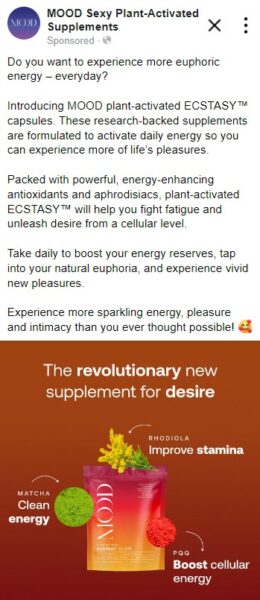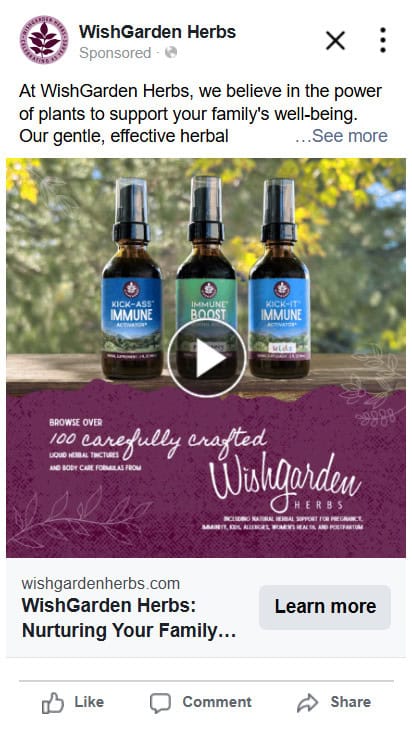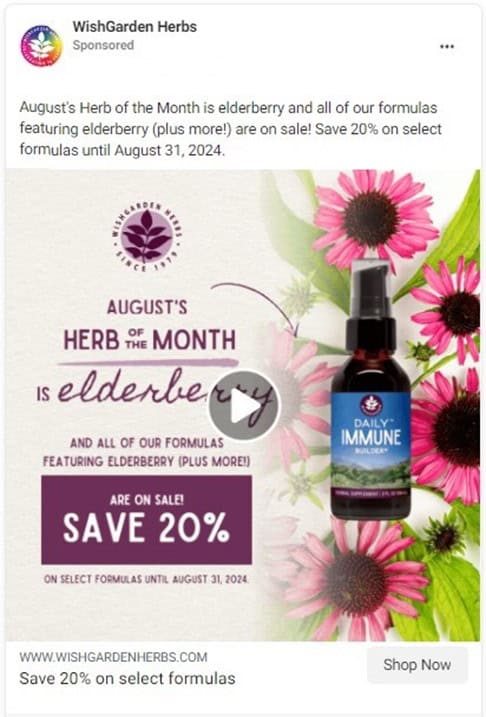A lot goes into creating a successful social media ad campaign — list-building, audience targeting, and budget management, to name a few.
But it’s become increasingly obvious over time that ad creative is the factor that will make or break your campaign ROAS.
Unfortunately, the ad creation process continues to be an afterthought for many marketing teams. Some overlook the reality of its importance, while others are intimidated by what they see as a time-consuming process.
But the truth persists: If you want to improve your social media ad campaign performance, improving your creative is the key to making it happen.
In today’s guide, you’ll find all the tools you need to get started. We’ve curated six tried-and-tested strategies used to supercharge our clients’ ad creative, along with real examples that have made all the difference for their social ad returns — including results like a 122% increase in ROAS and a 70% increase in ad revenue.
Want a professional to take your social ad creative to the next level?
Contact us today to learn more about our High-Performance Social Ad Creative design services.
6 Strategies for Designing Effective Social Media Ad Creative
- Employ a full-funnel strategy.
- Test and use several types of content.
- Use cohesive branding.
- Invest in influencer- and user-generated content.
- Refresh your creative.
- Focus on value-added messaging.
1. Employ a full-funnel strategy.
The number one secret to our client’s social media advertising success?
Using a full-funnel approach with their ad creative.
Many brands that are new to paid social focus on one thing: generating sales. But, by only serving ads with a conversion focus, you run into several challenges:
- A possible sales ceiling: Conversion-focused ads work best with audiences who are familiar with and interested in your product or service. But what happens when those audiences are exposed to the same ad over and over again? Ad fatigue sets in — and so does the law of diminishing returns. You can only mine so many sales out of the same audience list, which eventually results in plateauing revenue numbers.
- A stagnant audience list: Bottom-funnel ads typically don’t attract the attention or interest of someone new to your brand and/or product. If a social media user doesn’t know what your brand or product is, it’s highly unlikely they’ll convert on a sales-focused ad or click on your website to learn more. Without top-of-funnel awareness ads, you cannot expose new audiences to your brand or product, and you’ll eventually run out of potential customers to target with your ads.

To avoid these situations, we work with our clients to create a full-funnel ad creative strategy based on the “See, Think, Do” model. This approach generates more sustainable, long-term returns than creative focused solely on conversions — because it guides a growing audience through every step of the buying process with attractive, engaging ad creative.
Here’s what those three steps look like in action:
Top of Funnel (“See”)
Social media offers perfect opportunities to reach new audiences who are unaware of your brand and product/service. Advertising platforms like Meta allow you to target users based on demographics like age, location, and interests — the latter of which is perfect for the first stage of our social media strategy.
- Audience: The biggest possible relevant audience that hasn’t yet shown purchase intent or interest in your brand
- Metric: Cost per mille (CPM)
- Goal: Reach as many relevant people as possible; increase brand awareness
With these goals in mind, your ad creative should focus on introducing your brand and product and piquing the interest of your potential audiences (from which you will retarget later on).
Some ideas that have served our clients well:
- Videos that feature influencers, customers, and founders explaining the product/service and how it works
- Images and videos displaying products/services with copy that introduces and describes the brand
Examples:


Middle of Funnel (“Think”)
Once you have exposed new audiences to your brand through top-of-funnel creative, your next round of ad creative should build upon that initial interest. Aptly named, this stage in the buying cycle is when your engaged audience is “thinking” about purchasing your product or service — and your ad creative needs to give them reasons to do so.
- Audience: A subset of your TOFU audience that has shown intent (engagement with your ads)
- Metric: Cost per engagement/landing page view
- Goal: Educate potential customers about unique selling points; generate ad engagement and website traffic
Your MOFU social ad creative (and copy) should, above all else, emphasize your value proposition. What are the features of your product/service that customers love most? What makes your brand and offerings unique from the thousands of other brands advertising in a customer’s social feed?
Get specific here. Use detailed ad copy, in-depth product videos, and carousels to illustrate your value propositions in an attractive, engaging manner. Some conversion-focused creative — such as customer testimonials and product reviews — can play double duty in your MOFU and BOFU campaigns.
Examples:



Bottom of Funnel (“Do”)
We’ve reached the final stage in the purchase funnel — the one where your brand needs to bring out the big guns and secure the conversion you’ve been nurturing your target audiences toward.
- Audience: A subset of your MOFU audience who are most likely to make a purchase; previous purchasers and loyal customers
- Metric: Cost per purchase/acquisition (CPA)
- Goal: Product purchases and/or lead acquisition
At this point, you’ll have already educated your retargeting audience about the benefits of your product/service. They know what to expect and why they should purchase; your BOFU creative should get them over the finish line with offers they can’t ignore.
We recommend a mix of:
- Customer testimonials and product reviews
- Discounts and promotions (limited-time offers generate a sense of urgency)
- Product/service demo and walkthrough videos
These topics can be incorporated into a variety of creative types, as seen below. The more diverse your ad creative, the better your chances of resonating with your engaged audiences — and the more likely you’ll get that final conversion.
Examples:



2. Test (and use) several types of content.
As the social media ad examples above illustrate, you can’t rely on a single ad type to generate results for your paid social campaigns.
Different audiences respond to different ad formats. The more variety you can include in your marketing campaigns, the more likely you’ll be to grab potential customers’ attention.
The exact mix of creative types that’s best for your business can only be unearthed through detailed A/B testing. So, when starting, we recommend including all of the following in your campaigns.
That way, you’ll more quickly identify what moves the needle for your customers — and be able to double down on your initial success.
Single-Image Ads
Single-image, static ads are often the easiest for brands to incorporate into their social campaigns. This is especially true of our eCommerce clients, who often have a large library of product images they can mine.
However, you can’t just post an image of a product or service and call it a day.
To provide as much context as possible for your customers, we recommend adding copy overlays on your images. This copy can highlight your product benefits, introduce who your brand is, and/or include crucial CTAs, such as limited-time offers.
Consider this before-and-after example:
Before:

After:

For those unfamiliar with The Shelf Shop (an online retailer of high-end, custom shelves), the first ad does little to indicate what the brand actually sells. In fact, anyone scrolling through their feed and seeing this ad for the first time would reasonably assume the ad is for paint, not shelves.
The second ad remedies the situation with an attractive picture of the products in use. For those still confused about what the product is, the logo placed to the right of the product makes it clear what The Shelf Shop is selling.
Read more about how creative optimizations like this helped The Shelf Shop increase its revenue by 70%.
Best Practices:
- Use unique imagery (not just manufacturer’s product images).
- Balance the use of images and copy in your graphics.
- Use copy overlay to provide additional context or include CTAs.
- Incorporate your brand logo.
- Create multiple sizes for best placement (1:9, 1:1, 4:5).
Carousel Image Ads
In contrast to single-image ads, carousel ads allow you to highlight more features and value props in a format designed for customer engagement. As long as your first image is interesting enough, audiences have to manually click through the rest of the carousel for more details — a perfect metric for evaluating audience engagement.
Carousel ads are great for both B2C and B2B brands. You can use multiple graphics to highlight various products, display multiple reviews/testimonials, and educate customers about your value propositions.



Best Practices:
- Use a cohesive graphic design that encourages clicking (arrows, numbers, etc.).
- Create an attention-grabbing first image.
- Balance the use of images and copy in your graphics.
- Add copy overlay to provide additional context or include calls-to-action (CTAs).
- Use 3–4 slides maximum.
- Create multiple sizes for best placement (1:9, 1:1, 4:5).
Animated Ads (GIFs)
GIFs are a great compromise between traditional image ads and more-involved video ads. With just a touch of motion, you can grab viewers’ attention in the feed and increase engagement in a way that static images can’t.
Be strategic about which aspects of your ad will be animated. Do you wish to highlight the product? The discount you’re offering? Whatever you choose will be where your audience’s attention goes, so be smart about your selection.


Best Practices:
- Don’t overdo the animation. Choose one or two features to highlight.
- Balance the use of images and copy.
- Add copy overlay to provide additional context or include calls-to-action (CTAs).
- Create multiple sizes for best placement (1:9, 1:1, 4:5).
Video Ads
Video content is undeniably the king of today’s digital ecosystem — and it’s no different with social media advertising.
Even short, low-production-value videos can make a huge difference in your campaigns’ performance. In fact, video ads were the secret to our client MOOD generating 122% higher ROAS — achieved just three days after incorporating video into existing Facebook ads campaigns.
The video below is hosted on YouTube. If you need assistance with viewing the video, please contact info@goinflow.com.
Many digital marketing teams balk at adding video to their campaigns for several reasons. They (understandably) worry about the editing time involved, as well as ideating and filming the content itself. But, in agonizing over producing a high-quality, professional-looking video, they actually overlook the value that authentic, lower-production-value video can add to their campaigns.
Think about it: Very few viral Instagram Reels or TikTok videos are airbrushed and perfect. They’re often filmed on a cell phone, with little preparation or rehearsal. And while we’re not saying that your social ads should be slap-dash or spur-of-the-moment, they should be imbibed with that authentic, “real” spirit.
Still need more proof? Consider the test we ran for our former client Vitrazza, in which we compared the effectiveness of high-production-value video (left) and lower-production-value video (right). To our client’s surprise, the lower-production-value video outperformed in both volume of sales and overall ROAS.

You can use short-form video in an endless amount of ways — to highlight product/service benefits, provide a walkthrough of your services, feature customer- and influencer-created content, and more.
As always, test different approaches to see which resonates with customers at different stages in the buying cycle.
Best Practices:
- Keep your videos under 30 seconds.
- Add closed captioning within your videos (don’t rely on automated captioning from social media platforms).
- Include an attention-grabbing hook within the first three seconds.
- Incorporate “talking head”-style content featuring real customers and/or influencers.
- Add copy overlay to provide additional context or include calls-to-action (CTAs).
- Create multiple sizes for best placement (1:9, 1:1, 4:5).
3. Use cohesive branding.
Whatever types of content you incorporate into your social ad campaigns, make sure they follow the same brand standards and guidelines.
Remember: If you’re using the “See, Think, Do” strategy properly, a large subset of your audience will be new to your brand and products. Aligning all of your creative with the same brand colors, logo, and copy will help those viewers connect the dots between your ads and your brand — improving the effectiveness of your creative as they get retargeted to over time.
Cohesive branding also establishes a strong brand identity, which is especially useful for those early-stage or smaller companies. Word of mouth remains a key aspect of driving sales and growth; if more people can recognize your brand in the wild (and the value propositions that it offers), you’ll expedite that overall growth.
4. Invest in influencer- and user-generated content.

By featuring real humans in your ad creative (whether real customers or paid influencers), you can save a significant amount of money — and, more importantly, improve engagement metrics for your social media campaigns.
In contrast to over-polished images and videos, user-generated content adds a sense of authenticity to your ads. It fits in well with the organic content being served on the feeds and feels less like the type of intrusive ads customers are tired of seeing.
More than anything else, however, user-generated content fosters a sense of community and trust among your prospective customers. Relatability in advertising is nearly two times as important as popularity; with UGC ad creative, customers can better imagine themselves using and enjoying your product or service — because they see someone like them doing the same.
Other benefits of using UGC in your ad creative?
- It proves product value. Customer testimonials and reviews can help prospective buyers overcome their objections, especially for high-priced products or services.
- It can lead to better ROI. UGC ad creative can cost very little or be completely free. You can incentivize customers to send in reviews, videos, and pictures with discount codes or free gifts — most of which will require a smaller investment than a professional photo shoot.
- It expands your audience base. Diversity is key here. If you can represent as many different kinds of people as possible in your creative, you are more likely to engage a wider base of prospective customers.
Find more tips for incorporating user-generated content into your campaigns in our complete guide here.
5. Refresh your creative.
The average person spends almost two hours browsing social networks each day. If they’re being shown the same ads over and over again from your brand, they’ll experience ad fatigue — which will result in poor performance for your campaigns.
You can avoid fatiguing your audience by regularly refreshing your ad creative. There’s no “magic number” when it comes to the frequency of your refresh; that depends on factors like your audience size, the number of creative options you’re currently using, and more.
At the minimum, we recommend our clients swap out old creative for new on a quarterly basis. In addition to preventing fatigue, this also allows for seasonal or sales-specific creative, based on quarterly business goals or needs.
Keep in mind: When swapping in a substantial amount of new creative, your campaigns may be set back to the learning phase, during which performance may stutter. However, once learning is complete, new creative can add a spark to lagging campaigns and are often well worth the swap.
6. Focus on value-added messaging.
Finally, looking past all the design elements that go into your social ad creative, there is one thing to keep in mind:
No matter the format, your social ad creative should clearly communicate the benefits of your product/service to your customers.
Your business is paying good money to serve its ads to customers on social platforms. Don’t squander the opportunity with aesthetically pleasing ad creative that does little to educate your customers about your brand or products.
Some value-props to consider:
- Why your brand and/or product is unique
- Why your product/service will make their lives better
- What your brand mission/values say about your business
- How your customer service/support goes above and beyond
- How your product/service quality stacks up against competitors
As demonstrated in the social ad examples above, these value propositions can be communicated in many ways — customer reviews, product descriptions, informative carousels, etc. The more reasons you can give audiences to check out your brand or buy your product, the more successful your social media ad campaigns will be.
Optimize Your Social Ad Creative With Our Team’s Help
Social media moves fast — and so do best practices for ad creative on the platforms.
If you’re struggling to generate significant returns with your Meta, LinkedIn, or other social ad campaigns, a change in creative may be just what you need.
The best practices presented in this guide are a good place to start, but that’s all they are: a starting point. Your social media marketing team will still need to invest significant time and money into testing which creative works best for your audiences to unlock maximum ROAS.
Fortunately, you can speed up that process by working with a team of experts like those at Inflow. With more than 130 years of combined experience in the field, we can quickly apply our proven marketing strategies to deliver faster returns for your business — without wasting time slogging through the nitty-gritty of the creative production process.
Learn more about our social media management and creative design services by scheduling a free consultation with our team today.










0 Comments